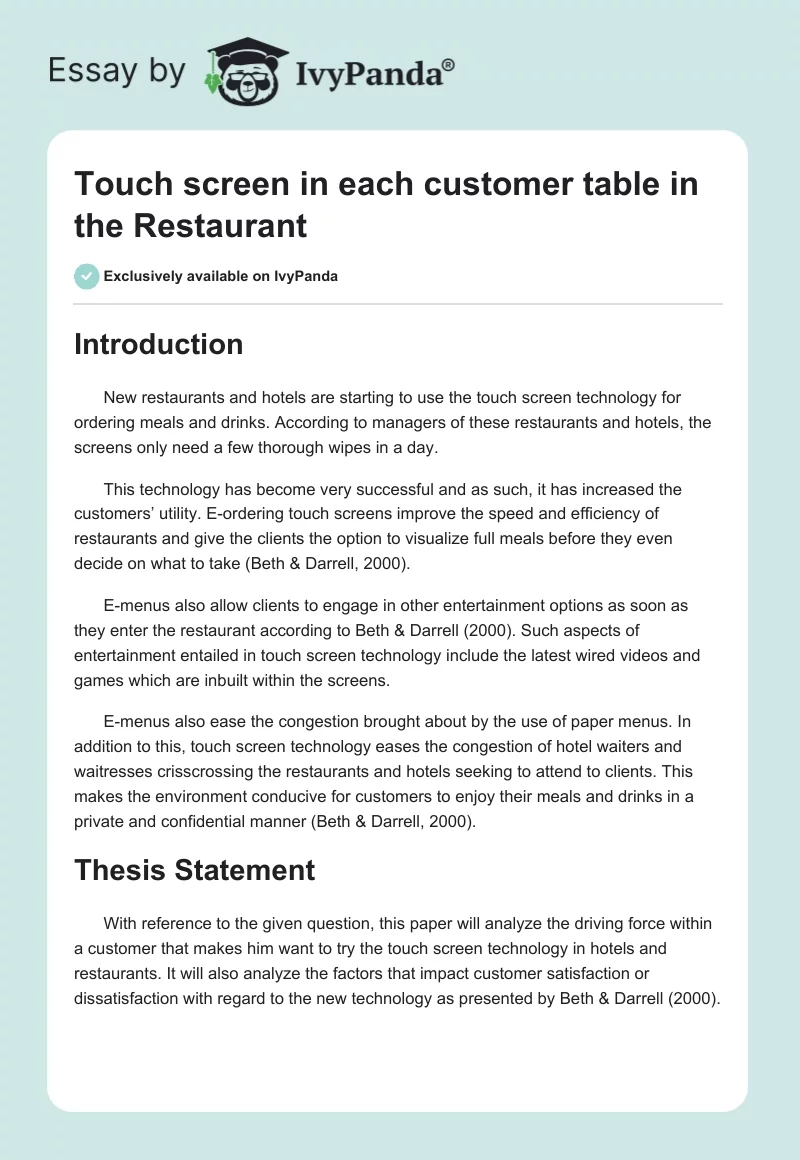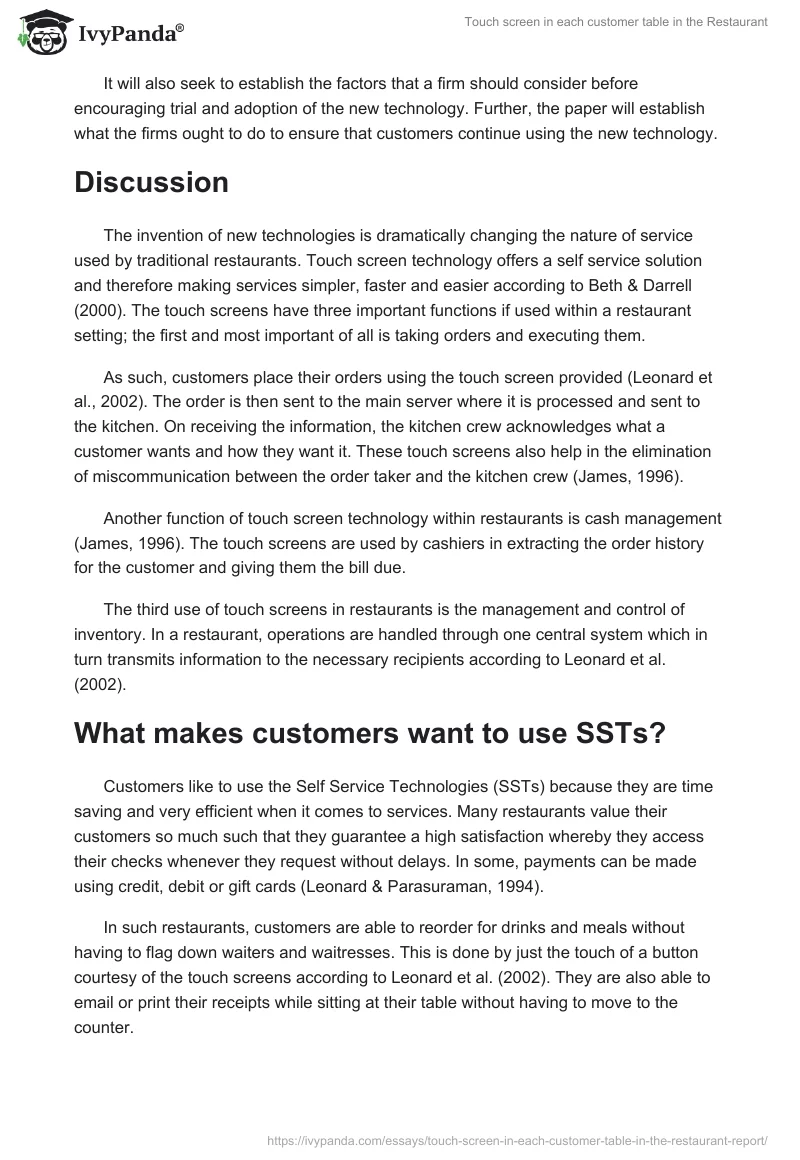Introduction
New restaurants and hotels are starting to use the touch screen technology for ordering meals and drinks. According to managers of these restaurants and hotels, the screens only need a few thorough wipes in a day.
This technology has become very successful and as such, it has increased the customers’ utility. E-ordering touch screens improve the speed and efficiency of restaurants and give the clients the option to visualize full meals before they even decide on what to take (Beth & Darrell, 2000).
E-menus also allow clients to engage in other entertainment options as soon as they enter the restaurant according to Beth & Darrell (2000). Such aspects of entertainment entailed in touch screen technology include the latest wired videos and games which are inbuilt within the screens.
E-menus also ease the congestion brought about by the use of paper menus. In addition to this, touch screen technology eases the congestion of hotel waiters and waitresses crisscrossing the restaurants and hotels seeking to attend to clients. This makes the environment conducive for customers to enjoy their meals and drinks in a private and confidential manner (Beth & Darrell, 2000).
Thesis Statement
With reference to the given question, this paper will analyze the driving force within a customer that makes him want to try the touch screen technology in hotels and restaurants. It will also analyze the factors that impact customer satisfaction or dissatisfaction with regard to the new technology as presented by Beth & Darrell (2000).
It will also seek to establish the factors that a firm should consider before encouraging trial and adoption of the new technology. Further, the paper will establish what the firms ought to do to ensure that customers continue using the new technology.
Discussion
The invention of new technologies is dramatically changing the nature of service used by traditional restaurants. Touch screen technology offers a self service solution and therefore making services simpler, faster and easier according to Beth & Darrell (2000). The touch screens have three important functions if used within a restaurant setting; the first and most important of all is taking orders and executing them.
As such, customers place their orders using the touch screen provided (Leonard et al., 2002). The order is then sent to the main server where it is processed and sent to the kitchen. On receiving the information, the kitchen crew acknowledges what a customer wants and how they want it. These touch screens also help in the elimination of miscommunication between the order taker and the kitchen crew (James, 1996).
Another function of touch screen technology within restaurants is cash management (James, 1996). The touch screens are used by cashiers in extracting the order history for the customer and giving them the bill due.
The third use of touch screens in restaurants is the management and control of inventory. In a restaurant, operations are handled through one central system which in turn transmits information to the necessary recipients according to Leonard et al. (2002).
What makes customers want to use SSTs?
Customers like to use the Self Service Technologies (SSTs) because they are time saving and very efficient when it comes to services. Many restaurants value their customers so much such that they guarantee a high satisfaction whereby they access their checks whenever they request without delays. In some, payments can be made using credit, debit or gift cards (Leonard & Parasuraman, 1994).
In such restaurants, customers are able to reorder for drinks and meals without having to flag down waiters and waitresses. This is done by just the touch of a button courtesy of the touch screens according to Leonard et al. (2002). They are also able to email or print their receipts while sitting at their table without having to move to the counter.
The touch screens also entertain the customers as they wait for their meals or drinks with games and trivia and this improves on a restaurants PR. They are also able to keep the customer informed on promotions and menu features. In addition to this, whenever there is are complains, customers can always forward them through the touch screens and get immediate response from the management (Leonard et al., 2002).
Customer satisfaction and dissatisfaction
The ability to access and control information raises the customers’ satisfaction. Research on customer satisfaction in regard to SST’s reveals many parallels to the general service quality study above. In a study of 823 incidents involving SST’s, 56% of the participants described their encounters as satisfactory (Leonard & Parasuraman, 1994).
Some of the factors that lead to customer dissatisfaction include; the quality of products and services being offered by the SSTs. Some of the customers would prefer to be served in person because restaurants will be able to deliver quality services and products to their customers (Devashish, 2004).
Another factor is the cost of the products and services offered by these restaurants. Some of them opt to transfer the cost of the gadgets like the touch screens to the customer in that they make their products and services more expensive to cater for the cost of these gadgets.
Another important factor is the educational level of the customers who frequent these restaurants. Some of the customers do not actually know how to operate the touch screens in the restaurants and may have a difficult time in trying to order for food and drinks and this poses a big challenge (Mary, 2001).
Factors that companies should consider
The factors that the companies should consider when encouraging the trial of the SSTs include;
The quality of products that the company offers through the SSTs
They must be able to offer the best quality of products for customers to be motivated to use them again (Devashish, 2004). They must be able to look at the cost of the products in that they should not charge customers any extra cost for the use of the gadgets and if this is observed, customers are motivated to use the services again (Mary, 2001).
Ability for service recovery
The company must be able to keep the SSTs updated and be able to continuously improve them. The way the company promotes or advertises the SSTs matters in that customers will be attracted by the best promotion with regard to SSTs (Mary et al., 2002).
For restaurants to ensure that customers continue to use these SSTs, they must be able to listen to the customers complaints and work on them accordingly to ensure that emerging issues are fixed immediately for continued customer satisfaction.
Reliability
If the services are not reliable, customers will seek the restaurants services at any one time in the future (Leonard et al., 2002). Companies must also put only those services that they consider basic into consideration in an effort towards avoiding exaggeration of SSTs. In addition to this, companies ought to just give the customers the fundamentals and best performances (Vince, 2000).
Recommendations
Some of the recommendations and future improvements that should be worked on in the SSTs include:
Researching on what the customers value and focus on their needs in that not all the customers have the same level of expertise putting various technologies into consideration (Matthew et al., 2003). In some cases the companies may need to provide an on-screen tutorial and make sure that the applications used are user friendly even to the most technically challenged user.
Companies should also have a clear strategic purpose for the SST in that just because a competitor has utilized SST, it does not necessarily allow another specific restaurant to utilize the same without doing a feasibility study to understand customers needs and wants (Leonard & Parasuraman, 1994).
The restaurant must also be able to provide protection and reassurances for privacy and security for the customers. The restaurants must be able to protect the customers from hackers whose intentions are to obtain private customer and employee data (Devashish, 2004).
The companies must involve the customers in the implementation of the SSTs in that the customers are main users of these SSTs and as such, it is very important to conduct a feasibility study from the customers to be able to know what exactly the customers’ needs (Eun-Ju et al., 2002).
The restaurants should also reduce SST failures in that whenever customers come in they should always be able to access the SST without any problem or interference (Matthew et al., 2003).
References
Beth, S, & Darrell, P, 2000, ‘Self-Service Lessons, HR Magazine’, 45: 5-10.
Devashish, P, 2004, ‘Self-service with a smile? Self-service technology (SST) encounters among Canadian business-to-business’, International Journal of Service Industry Management, 15 (2): 200-219.
Eun-Ju, L, et al., 2002, ‘The influence of communication source and mode on consumer adoption of technological innovations’, Journal of Consumer Affairs, 36 (1): 1-27.
James, A, 1996, ‘Keeping the Customer Satisfied’, InformationWeek, 591: 55-60.
Leonard, B, et al., 2002, ‘Understanding Service Convenience’, Journal of Marketing, 66 (3): 1-17.
Leonard, B, & Parasuraman, A, 1994, ‘Improving service quality in America: Lessons Learned, Academy of Management Executive’, 8 (2): 32-52.
Mary, B, 2001, ‘Self-Service Technologies: What Do Customer’s Expect?’ Marketing Management, spring, 10 (1): 10-11.
Mary, B, Ostrom, A, & Natthew, N, 2000, ‘Implementing Successful Self-service Technologies’, Academy of Management Executive, November, 16 (4): 96-109.
Matthew, M, et al., 2003, ‘The influence of technology anxiety on consumer use and experiences with self-service technologies’, Journal of Business Research, 56 (11): 899-906.
Vince, C, 2000, ‘What’s behind the curtain for self-service technology?’ Employee Benefit News, 14 (13): 31-33.


